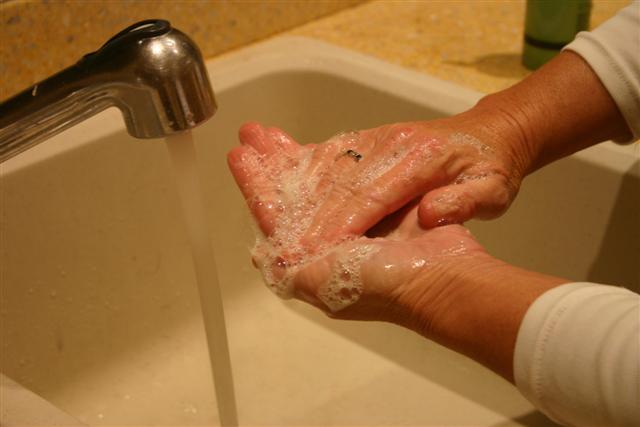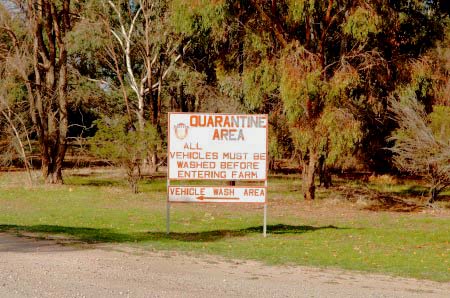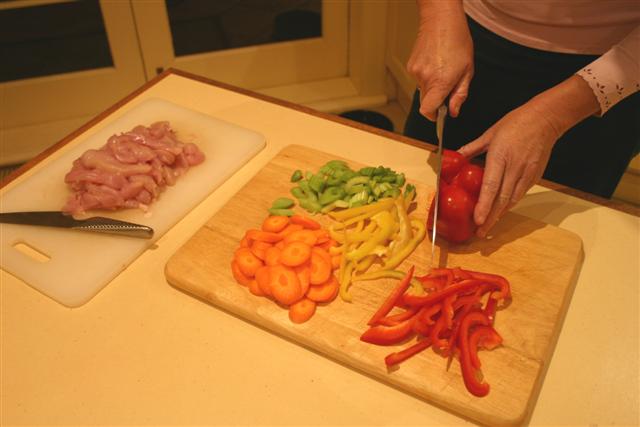Food Safety
Food Safety
The consumption of adequate safe and nutritious food is critical to our health and well-being. Keeping our food safe requires an understanding of food safety principles. There are a number of contaminants (or hazards) that could appear in our food and contamination may occur at any stage during the production, processing, storage and preparation of our food. Good food safety practices throughout the food production chain from “farm to fork” will minimise the chance of contamination of our food and also minimise, or even eliminate, the impact of contamination that has already occurred.

Hygiene is critical to food safety (Source: Australian Chicken Meat Fed.)
Food safety hazards
The hazards that could contaminate our food fall into three categories:
- Physical Hazards – These include contaminants such as pieces of glass or metal. They have the potential to cause physical injury if consumed. Once the contaminant is present in the foodstuff the risk can only be eliminated if the contaminant is noticed and removed.
- Chemical Hazards – These include contaminants such as toxic chemicals, unsafe levels of cleaning and sanitising chemicals or toxins that may be produced following contamination with certain organisms, such as bacteria or fungi. In some cases, killing or inactivating the organism may not destroy an existing toxin.
- Biological Hazards – These include organisms such as bacteria, viruses, fungi and parasites. Generally, these contaminants will only cause a health problem if they are alive and able to infect the consumer when ingested.
An understanding of these potential food safety hazards reveals the inter-relationship between biosecurity, animal health and food safety. In order to minimise the risk of contamination of poultry eggs and meat for consumption, it is important to minimise the risk of contaminants reaching our commercial poultry flocks. Good farm management and hygiene practices and effective biosecurity procedures are critical to achieving this goal. These practices will minimise the chance of contamination and will optimise bird health, which allows the birds’ own immune system to be another safeguard to prevent potential contamination.
Food safety programs and HACCP
Most food supply businesses use food safety programs to protect the safety of their products. These programs are generally based on a system called HACCP (Hazard Analysis Critical Control Point). The HACCP system was initially developed for NASA by the Pillsbury Company in order to supply safe food for astronauts. The HACCP system involves identifying things that can go wrong in the food production operation (i.e. hazards), putting in place steps which will prevent them happening, monitoring those steps to ensure they are working and documenting the entire process. HACCP principles can be applied to any stage of the production, processing, storage and preparation of food.
HACCP is a step-by-step system. In all, there are 12 steps required to develop and implement a HACCP plan:
To develop a HACCP plan:
1. Form a HACCP Team and define the scope of the HACCP plan. The team must provide expertise in food safety risks and risk management as well as the day-to-day operations of the business.
2. Describe the products produced by the business and identify the intended customer.
3. Construct a detailed flow chart of the production process, and then verify it.
4. List all the potential food safety hazards associated with each stage of the production process, conduct a hazard analysis to determine the likelihood (relates to the probability of the occurrence of a hazard e.g. the probability that it will occur every time or one chance in a million) and potential severity (relates to the magnitude of a hazard i.e. how many people will get sick or what will be the liability costs) of all hazards and consider any control measures.
Each hazard is rated using a system that suits your products. This may be a simple system such as “low-high” rating. As a general rule, hazards that involve low likelihood and low severity, and are easily controlled, are usually not included in a HACCP plan. An “overall” risk rating is therefore given to assist in determining what hazards to include.
| Severity | Likelihood | Overall Risk Rating |
| Low | Low | Low |
| High | Low | High |
| Low | High | High |
| High | High | High |
All hazards that receive a high overall risk rating must be controlled in the HACCP plan.
5. Determine the Critical Control Points (CCP). These are points at which the hazard must be controlled to prevent a food safety risk in the final product. There will also be steps in the process where control is desirable but not critical – these are known as control points (CPs).
6. Establish critical limits for each CCP. This is the measurement which determines whether or not the hazard is being effectively controlled.
7. Establish a monitoring system for each CCP.
8. Establish corrective action plans for any deviation outside of the critical limits for a CCP.
To implement or put a HACCP plan into place:
9. Establish documentation and record-keeping. The HACCP plan should be documented and all staff should have available the information they require to perform their duties in accordance with the HACCP plan. This will often mean documenting work instructions for each job that staff do. Good record keeping is a critical component of an effective HACCP plan as it ensures that the business manager can determine whether the plan is achieving its goals or if there is a problem that needs to be addressed.
10. Establish verification procedures. This may include some form of additional testing to verify that the control measures in the HACCP plan are having the desired effect on the final products.
11. Train staff for HACCP implementation.
12. Maintain and improve the HACCP plan. HACCP plans must be updated for any changes to the operations of a business or to rectify any problem identified through the monitoring or verification procedures.
(Steps based on the Australian Egg Corporation Limited’s Egg Corp Assured training program)
Food safety regulation for the commercial poultry egg and meat industries
The safety of all food produced and sold commercially in Australia is regulated by the State and Territory governments. The mechanisms and procedures by which this regulation is managed may differ in each State or Territory. Information on food safety requirements for food industries in each State and Territory can be found at:
- Australian Capital Territory Government, Health web site
- NSW Food Authority web site
- Northern Territory Government website
- Safe Food Queensland web site
- State Government of South Australia, SA Health website
- State Government of Tasmania, Department of Health and Human Services
- State Government of Victoria, Department of Human Services web site
- State Government of Western Australia, Department of Health website
In general, regulation is based on a requirement for commercial food businesses to have in place a food safety program that ensures adherence to the national Food Standards Code. This Code was developed by Food Standards Australia New Zealand (FSANZ) and is enforced by the State and Territory Governments.
The Code can be downloaded or purchased from the Food Standards Australia New Zealand web site
Food safety programs in the commercial poultry egg and meat industries
The poultry egg industry
Australian Eggs Limited has launched Egg Standards of Australia (ESA) – for rearing and laying farms, an updated quality assurance program for the egg industry. ESA is a voluntary quality assurance program that has been developed through an extensive consultation process with egg farmers to provide a practical mechanism to demonstrate compliance with egg production standards. ESA replaces the current industry scheme, Egg Corp Assured (ECA), providing greater clarity and a more robust set of compliance standards that have been independently reviewed against current Australian customer and regulatory requirements.
ESA has been developed to provide a compliance framework for egg farmers in meeting the needs of regulators, retailers, farmers and egg buyers in areas including hen welfare, egg quality, biosecurity, food safety, work health and safety and environmental management.
The existing ECA Grading and Packing Standard remains current. A consultative review of the ECA Grading and Packing standard will be undertaken in the coming months, with the intention of releasing the ESA Grading and Packing Standard in 2018.

Quarantine sign at entrance to poultry farm (Source: Australian Chicken Meat Fed.)
The poultry meat industry
At the farm
Sound husbandry practices in growing, collecting, transporting and handling birds reduces the risks of food safety hazards in poultry meat products. Australia’s poultry meat industry aims for best practice, constantly researching to develop new techniques that will enhance both bird health and welfare and food safety for consumers.
During processing
At processing, good food handling practices are supported by systems which ensure consistency and high standards. These include:
• Quality assurance programs, notably HACCP.
• Vendor quality assurance programs audit for strict compliance with the stringent quality assurance programs of a number of major customers.
All quality assurance programs are supported by third-party auditors to ensure that standards remain consistently high and any problems are identified and addressed quickly. It is not unusual for a processor to be audited 15 times in a year by various bodies. These programs provide a high degree of assurance that food is produced, processed, packaged, stored and transported in accordance with strict food safety requirements.

Food safety at home (Source: Aust. Chicken Meat Fed.)
Food safety at home
In Australia, government regulation and the use of food safety programs by food supply businesses have ensured a high standard of safety in the foods we produce and import. However, inappropriate storage and handling and inadequate cooking of food products after purchase may result in food safety risks for consumers.
For helpful tips on food safety at home for eggs go to Australian Eggs Limited and for chicken go to Australian Chicken Meat Federation.
Campylobacter
Campylobacter is the most common cause of infectious bacterial enteritis (food poisoning) worldwide. There are two species which cause human disease and Campylobacter jejuni accounts for over 90% of infections causing disease and Campylobacter coli making up the remainder.
LEARN MORE
Salmonella
Bacteria belonging to the genus Salmonella are an important cause of food poisoning of humans. In certain parts of the world, Salmonella are also an important cause of disease in poultry.

